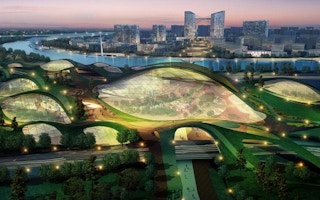The making of an eco-city is more than just putting technology and ideals together; it requires a degree of practicality and should be able to be replicated elsewhere, said experts at the opening day of the International Green Building Conference (IGBC).
Three key factors identified by speakers at a session on eco-cities were practicality, scalability and replicability.
The first refers to how affordable the development is, and how livable the end result will be; the second to whether the techniques and technologies applied can be reused for districts and cities of different sizes, geographies and demographics; and the third, whether the development conforms to international standards and can therefore be replicated elsewhere in the world.
With today’s increasing focus on greening urban developments, it is now possible to address all three factors, said the experts: by technical ingenuity, social awareness, regulatory support or a combination of the three.
Cost, for one, can be surmounted through early design planning and the implementation of passive design features. These include building orientation to best capture sunlight or rainwater, technology that minimises energy loss, the use of inexpensive materials and even simple modifications such as having minimal exterior decorations, said Ho Tong Yen, chief executive of Sino-Singapore Tianjin Eco-City Investment and Development.
He and three other eco-cities experts spoke on Wednesday at the Eco-Cities symposium on city-related issues as part of a three-day summit that gathers green building experts, policymakers and businesses in Singapore to discuss green building topics.
According to Mr Ho, the cost of an eco-friendly building that is properly designed and constructed is only about five to eight per cent higher than that of a conventional building. Furthermore, it can typically be made back over several years of cost savings. “Green buildings must be affordable; only then can they be practical and replicable,” he observed.
Getting a development to conform to international standards can also be achieved where regulators have laid out a clear blueprint. There are many district assessment methodologies worldwide; Singapore, for example, has the BCA Green Mark for Districts scheme, introduced in 2009 as an extension of the existing BCA Green Mark.
The Districts scheme is now entering its second version, which is expected to be ready by the end of September. According to Jeffery Neng, deputy director with the Building and Construction Authority (BCA), implementing the scheme’s requirements across a district will result in 10 to 40 per cent energy savings and more than 40 percent water savings at district level.
However, regulatory support is not always so well defined, noted Tony Chan, associate manager of Arup in Hong Kong. In some jurisdictions, the onus often falls on designers to find a way of translating sustainability concepts into action.
In China, for example, sustainability is difficult to put into practice on the ground as there is no certainty that developers will follow the original plan, he said.
“It is critical to quantify sustainability performance,” he added, citing rating tools such as carbon-footprinting which measures the impact of a company’s operations, and integrated resource management models which track how many resources are being consumed by a project.
“You must look at the environmental, social and economic practicality indicators, and have performance targets and technical requirements that are specific to projects,” he said.
In addition, a clear and specific public and private sector collaboration model must be set up - one that defines the roles of the government, utility providers and developers, he noted.
Mr Chan explained that at regulatory levels, the model should offer a proactive implementation strategy for authorities; at implementation levels, it should encourage market response, because sustainability requires market support to be economically viable in the long term. “You have to set out the business case: who pays and who gains?” he added.
The event’s speakers highlighted a fourth key factor which seldom gets much attention amidst the publicity more frequently given to green ideals and technology. That is the human factor: acceptance and mindset.
“Sustainable development is not just about being green,” said Mr Ho. “We need to persuade the general public that green buildings are desirable - that we want to live, work and play in these buildings.” One of the principles involved in the development of Tianjin Eco-City, he adds, is harmony: harmony between people and people; people and the environment; and people and the economy.
Mr Neng agreed: “An eco-district must be designed around people.”
Mr Chan concluded the afternoon session by highlighting current global challenges – population growth, resource scarcity, climate change and more.
“We know exactly what has to be done in terms of sustainability and how to go about it, but we need to constantly remind ourselves why we should do it,” he noted.
Eco-Business.com’s coverage of the International Green Building Conference 2011 is brought to you by City Developments Limited.
For other news from Singapore Green Building Week, including the International Green Building Conference 2011 and Bex Asia 2011, click here.










